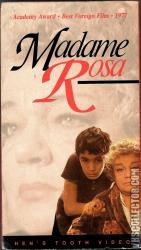Madame Rosa
Catalog Number
1030
-
Primary Distributor (If not listed, select "OTHER")
Catalog Number
1030
Primary Distributor (If not listed, select "OTHER")
Release Year
Country
N/A (NTSC)
N/A | N/A | N/A
N/A | N/A
La vie devant soi (1978)
Additional Information
Additional Information
Just before one story begins and another one ends, there is a love story for all time.
Madame Rosa (Simone Signoret) is an aging former prostitute who, in her dotage, makes a living by caring for the children of other prostitutes in Paris' Arab community. Haunted by memories of her experiences in a Nazi concentration camp, Rosa is seized with the notion that the Gestapo is still after her. She thus begs one of her young charges (Samy Ben Youb) not to give away her "hiding place." Madame Rosa was based on Momo, a novel by one Emile Ajar (better known as Romaine Gary).
The story of Madame Rosa and Momo unfolds in a multi-ethnic, multi-religious and multi-cultural community. The profound emotional bond between the two main characters, one an old Jewish woman and the other a young Arab boy, is what drives the film emotionally from the beginning to the end. The film also emphasizes the compassion and empathy that can be found in such a disadvantaged community context through the helping gestures of the secondary characters. Madame Lola, for example, while being bluntly described by Momo as "a transvestite" who had been "a boxing champion in Senegal", is depicted in both the book and the film without any sensationalism. To the contrary, she is presented as a compassionate human being who is concerned by the poverty of Madame Rosa and Momo, giving them food and money without expecting anything in return. Momo says of her that "she's really somebody", that he "likes her"; Madame Rosa declares, "She's a Saint, I don't know where we'd be without her". The dynamic represented between Madame Rosa, Momo and their transsexual prostitute neighbor, Madame Lola, stands as a good example of the type of deeply humanistic values and respect for human difference, whether that difference is of a sexual, religious, or racial nature, that is embedded in Romain Gary's written text and further successfully emphasized through Moshé Mizrahi's cinematographic representation of the story.
Madame Rosa (Simone Signoret) is an aging former prostitute who, in her dotage, makes a living by caring for the children of other prostitutes in Paris' Arab community. Haunted by memories of her experiences in a Nazi concentration camp, Rosa is seized with the notion that the Gestapo is still after her. She thus begs one of her young charges (Samy Ben Youb) not to give away her "hiding place." Madame Rosa was based on Momo, a novel by one Emile Ajar (better known as Romaine Gary).
The story of Madame Rosa and Momo unfolds in a multi-ethnic, multi-religious and multi-cultural community. The profound emotional bond between the two main characters, one an old Jewish woman and the other a young Arab boy, is what drives the film emotionally from the beginning to the end. The film also emphasizes the compassion and empathy that can be found in such a disadvantaged community context through the helping gestures of the secondary characters. Madame Lola, for example, while being bluntly described by Momo as "a transvestite" who had been "a boxing champion in Senegal", is depicted in both the book and the film without any sensationalism. To the contrary, she is presented as a compassionate human being who is concerned by the poverty of Madame Rosa and Momo, giving them food and money without expecting anything in return. Momo says of her that "she's really somebody", that he "likes her"; Madame Rosa declares, "She's a Saint, I don't know where we'd be without her". The dynamic represented between Madame Rosa, Momo and their transsexual prostitute neighbor, Madame Lola, stands as a good example of the type of deeply humanistic values and respect for human difference, whether that difference is of a sexual, religious, or racial nature, that is embedded in Romain Gary's written text and further successfully emphasized through Moshé Mizrahi's cinematographic representation of the story.
Related Links
Related Releases1
Catalog Number
VA 4004
Primary Distributor (If not listed, select "OTHER")
La vie devant soi (1978)
Release Year
Catalog Number
VA 4004
Primary Distributor (If not listed, select "OTHER")
Catalog Number
VA 4004










Comments0
Login / Register to post comments